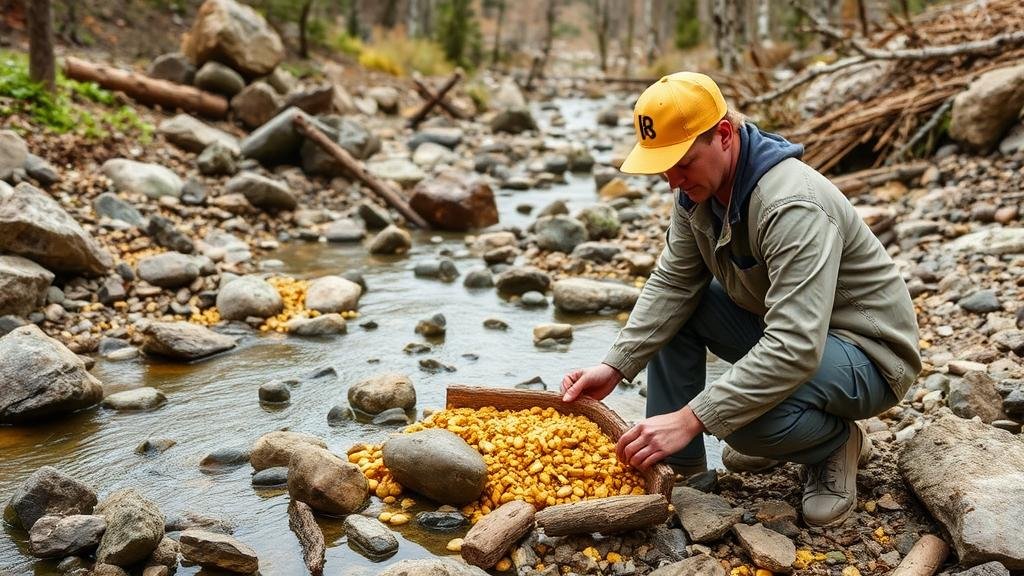Early Placer Mining Methods: Recovering Gold From Floodplains
Early Placer Mining Methods: Recovering Gold From Floodplains
Placer mining, the extraction of valuable minerals from alluvial deposits, has a long and storied history, particularly in the pursuit of gold. The methods employed during the early days of mining were rudimentary yet effective, allowing gold seekers to capitalize on the natural processes that deposited gold in riverbeds and floodplains. This article delves into the early methods of placer mining, focusing on the techniques used to recover gold from floodplains.
The Nature of Placer Deposits
Placer deposits are formed when sediments are washed down from eroded rock, transporting gold particles and other heavy materials. In floodplains, these deposits can accumulate due to the changing flow of water, which separates heavier materials from lighter ones. Understanding the formation and characteristics of these deposits is key to the methods employed in early placer mining.
- Hydraulic Sorting: Waters ability to sort materials by weight is essential in placer mining, as heavier gold particles settle at the bottom.
- Alluvial Fan Development: As rivers slow and spread out, they create fans that concentrate gold and other minerals, forming lucrative deposits.
Techniques Used in Early Placer Mining
The early miners employed several techniques to extract gold from widespread floodplain deposits. Each method was designed to take advantage of the unique characteristics of the environment while utilizing simple tools and equipment.
Panning
Panning is perhaps the most iconic method of placer mining. technique involves using a shallow pan to separate gold from other sediments. Miners would scoop up sediments from riverbeds, submerging the pan in water and using a gentle swirling motion to allow lighter materials to escape while retaining the denser gold particles.
- This method was widely practiced during the Gold Rush in California, where countless individuals flocked to rivers believing they could strike it rich.
- According to estimates, a successful gold panner could yield between $1 and $5 worth of gold in a day, depending on site conditions.
Rockers and Cradles
The rocker box, also known as a cradle, was an advancement that allowed miners to process larger quantities of material. This device consists of a wooden box with a hinged top that is rocked back and forth. As water flows through the box, the heavier gold particles settle in the sluice while lighter sediment is washed away.
- Rocker boxes could increase yield significantly, with some miners reporting earnings of up to $20 per day using this method.
- This method was especially prevalent in the Sierra Nevada region, where numerous gold miners took advantage of the abundant river systems.
Sluicing
Sluicing involves the use of a sluice box, a long, narrow trough where water flows continuously. Gold-laden gravel is shoveled into the box, and its design helps to trap gold particles while allowing lighter materials to wash away.
- This method improves efficiency, as it allows for the processing of large amounts of material simultaneously.
- The introduction of riffles–angled barriers in the sluice–enhanced the process by creating turbulence that captures gold.
Challenges and Considerations
While early placer mining methods were successful, they were not without their challenges. Environmental concerns, such as the impact on local ecosystems and water quality, began to arise with the increased mining activity.
- Hydraulic mining techniques, which redirected large volumes of water to wash away entire hillsides, led to significant environmental degradation.
- Legal disputes over land rights and water usage became common as miners encroached on each others claims.
Conclusion and Modern Implications
Early placer mining methods played a critical role in the gold rushes of the 19th century and laid the groundwork for future mining techniques. While these methods have evolved with modern technology and increased regulatory oversight, the fundamental principles of utilizing water to separate gold from sediment remain. Understanding these early practices provides valuable insights into the evolution of mining and its interaction with the environment.
For modern miners and enthusiasts, the legacy of early placer mining serves as a reminder of the ingenuity of those who sought fortune in the rivers and floodplains and the responsibility that comes with resource extraction.



